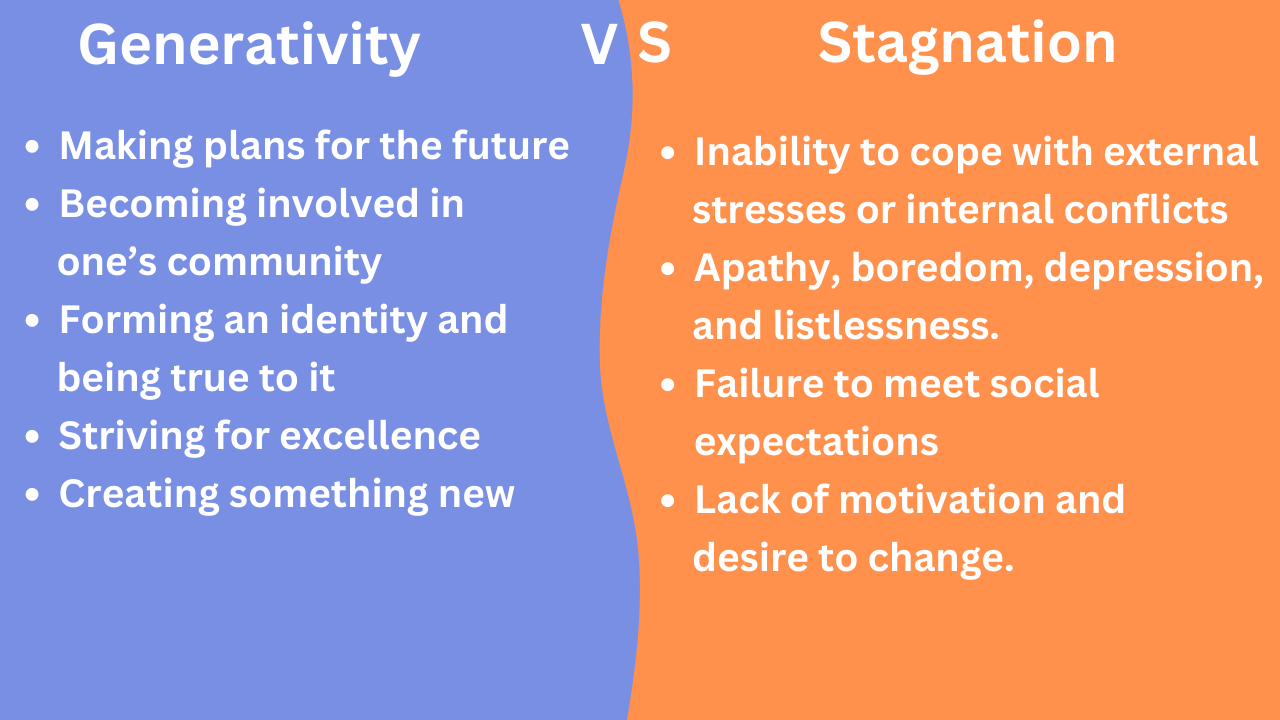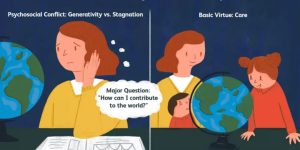Physical Address
304 North Cardinal St.
Dorchester Center, MA 02124
Physical Address
304 North Cardinal St.
Dorchester Center, MA 02124

Generativity vs stagnation is a critical psychosocial stage in Erik Erikson’s theory of human growth, where individuals in middle adulthood—typically ages 40 to 65—face the challenge of contributing meaningfully to society or risking a sense of stagnation.
This seventh stage emphasizes creating a legacy through mentoring, parenting, or community work, fostering personal fulfillment and personality development.
Recent research up to 2025, including a May 2025 overview of Erikson’s stages, highlights how resolving this conflict positively influences cognitive and emotional health in later life, with studies showing links to better functional capacity and well-being.
By experiencing generativity, people build resilience against stagnation and emotional despair, setting a foundation for ego integrity vs despair in old age.
Erik Erikson, a renowned psychoanalyst born in 1902, developed his theory of psychosocial development by expanding on Freud’s ideas, focusing on social interactions across the lifespan.

Erikson’s theory posits that personality evolves through eight distinct crises, each tied to a specific age range and social demand. Unlike biological stages, these emphasize how relationships and culture shape identity.
In Erik Erikson’s framework, success in each stage builds virtues like hope or wisdom, while failure leads to maladjustments.
Updated analyses in 2025, such as a ResearchGate publication, reaffirm its relevance in developmental psychology, applying it to modern issues like work-life balance.
Erikson stressed that unresolved conflicts from earlier stages can amplify challenges in later ones, making holistic growth essential.
Erikson’s model outlines eight stages of psychosocial development, each with a core conflict influencing human development.
From infancy to old age, these stages guide how individuals navigate social expectations. For instance, early stages focus on trust and autonomy, laying groundwork for later complexities.
A key aspect is progression: Success in one stage facilitates the next. Recent 2025 reviews note adaptations for diverse cultures, emphasizing flexibility in age ranges. Here’s a table summarizing all eight stages for clarity:
| Stage | Age Range | Conflict | Virtue Gained | Potential Maladjustment |
|---|---|---|---|---|
| 1 | Infancy (0-18 months) | Trust vs Mistrust | Hope | Fear, suspicion |
| 2 | Early Childhood (18 months-3 years) | Autonomy vs Shame/Doubt | Will | Compulsiveness, doubt |
| 3 | Preschool (3-5 years) | Initiative vs Guilt | Purpose | Ruthlessness, inhibition |
| 4 | School Age (5-12 years) | Industry vs Inferiority | Competence | Inertia, inferiority |
| 5 | Adolescence (12-18 years) | Identity vs Role Confusion | Fidelity | Fanaticism, repudiation |
| 6 | Young Adulthood (18-40 years) | Intimacy vs Isolation | Love | Promiscuity, exclusion |
| 7 | Middle Adulthood (40-65 years) | Generativity vs stagnation | Care | Rejectivity, stagnation |
| 8 | Maturity (65+ years) | Ego integrity vs Despair | Wisdom | Presumption, disdain |
Stagnation is the seventh stage in Erikson’s psychosocial model, occurring during middle adulthood. Here, the psychosocial crisis revolves around contributing to future generations versus self-absorption.
According to Erikson, adults seek to guide the next wave through teaching or innovation, avoiding a stagnant existence.
Modern interpretations in 2025 studies, like those in Acta Psychologica, validate this by developing new measures of psychosocial development.
They show generativity refers to proactive legacy-building, while stagnation may manifest as regret. Resolving this stage positively enhances adult development, influencing overall life satisfaction.
Middle adulthood marks a peak of responsibility, where career, family, and societal roles intensify the generativity versus stagnation conflict.
Individuals often reassess life goals, balancing personal ambitions with communal contributions. Midlife energy drives actions like volunteering, which foster a sense of generativity.
Research up to 2025 indicates that middle age stressors, such as health changes, can tip the scale toward stagnation.
A 2023 MDPI study on Japanese adults found higher generativity in midlife correlates with maintained physical function in late adulthood. Thus, active engagement during this period prevents feelings of stagnation.
Generativity refers to the drive to nurture and improve the world beyond oneself, encompassing creativity and care.
In Erikson’s theory, it involves producing ideas, products, or relationships that outlast the individual. Characteristics of generativity include empathy, productivity, and forward-thinking.
Generativity involves acts like parenting or advocacy, promoting societal progress. A 2025 Verywell Health article emphasizes its role in mental resilience, noting that generativity may buffer against midlife crises. People achieve generativity by aligning personal strengths with communal needs, leading to profound fulfillment.
Characteristics of stagnation involve inertia, where individuals feel unproductive and disconnected.
This opposite of generativity leads to self-focus without growth, often resulting in boredom or resentment. Signs of stagnation include avoiding new challenges or regretting missed opportunities.

In Erikson’s view, stagnation and generativity coexist as a spectrum, but 2025 research suggests they are distinct.
For example, experience stagnation might stem from unresolved prior stages, amplifying isolation. Recognizing these traits early allows intervention, shifting toward generative behaviors.
Examples of generativity abound in everyday pursuits that benefit others. Mentoring a junior colleague, for instance, imparts knowledge and builds confidence. Examples of generativity include writing books, starting nonprofits, or coaching youth sports, all creating lasting impact.
Focused on generativity, these actions enhance personal purpose, as per Erikson psychosocial insights.
To develop a sense of generativity, start with self-reflection on passions and skills. Engage in community service or skill-sharing workshops. Generativity in midlife thrives on building networks, like joining professional groups.
Practical steps include setting legacy goals, such as documenting family history. 2025 updates highlight digital mentoring via online platforms, adapting Erikson’s theory to tech-savvy eras. Consistent effort transforms routine into meaningful contributions, countering stagnation.
Consequences of stagnation extend to mental health, fostering depression or anxiety. Unresolved, it leads to less successful psychosocial development, affecting relationships and self-esteem. Stagnation is the seventh conflict, where inaction breeds regret.
A 2020 PMC study links unmet generative goals to poorer cognitive outcomes. In later life, this manifests as isolation, underscoring the need for early resolution.
Intimacy vs isolation from young adulthood directly influences generativity vs. Strong bonds built earlier provide support for generative acts. Without intimacy, individuals may struggle with trust, hindering contributions.
Stage 6, intimacy, equips adults for collaborative efforts in midlife. 2025 analyses show that solid partnerships amplify generativity, while isolation predisposes to stagnation.
Initiative vs guilt in preschool years fosters creativity, essential for later generativity. Children learning to take risks without fear develop proactive personality traits.
This early stage of development sets patterns; guilt can lead to hesitation in adulthood. Integrating these foundations supports overcoming psychosocial challenges.
Ego integrity vs despair follows generativity vs stagnation, where elders reflect on life. Success in generativity aids acceptance, yielding wisdom.
Ego integrity and despair hinge on prior contributions. Emotional health in late life improves with generative histories, as 2025 studies confirm.
Setting the stage for cognitive vitality involves generative pursuits stimulating the mind. Mentoring or learning new skills combats decline.
Stage for cognitive and emotional balance is set in midlife. Midlife Eriksonian psychosocial development predicts late-life cognitive and emotional health, per 2016 research cited in 2025 articles.
Psychosocial challenges evolve, from earlier psychosocial trust-building to current psychosocial generativity. Each stage interconnects, demanding adaptation.
Theory suggests resilience grows through resolution. A longitudinal study from age cohorts in recent decades shows cumulative effects on well-being.
Advancements in 2025 include new scales distinguishing generativity and stagnation. Acta Psychologica’s study validates separate measures for older adults, linking stagnation to eudaimonic well-being.
These tools refine Erikson’s theory of psychosocial development, aiding interventions. Suggests that generativity enhances hedonic aspects, while stagnation impacts purpose.
Identity development from adolescence underpins generativity vs. A stable self allows outward focus, preventing stagnation.
Unresolved identity leads to midlife confusion. Adult stage of human development benefits from revisiting earlier crises.
While primarily midlife, young adulthood glimpses of stagnation occur if intimacy falters. Early career ruts mimic this.
Preventing it involves proactive steps, aligning with Erik Erikson’s lifespan view.
Developmental psychology validates Erikson’s stages through empirical studies. It explores how personality development unfolds socially.

2025 integrations with neuroscience show brain changes supporting generativity.
Integrity vs despair culminates the journey, reflecting on generativity. Positive outcomes yield peace; otherwise, bitterness.
This stage reinforces midlife’s importance in psychosocial development theory.
FAQs About Generativity vs Stagnation
What is generativity vs stagnation?
Generativity vs stagnation is Erikson’s seventh stage, where middle adults contribute to society or face unfulfillment, impacting legacy and well-being.
How do you achieve generativity?
To achieve generativity, engage in mentoring, community work, or creative projects that benefit others, fostering purpose and growth.
What are signs of stagnation?
Signs of stagnation include feeling stuck, lacking motivation, regret, and disconnection from meaningful activities or relationships.
Why is middle adulthood key for this stage?
Middle adulthood offers peak opportunities for influence, balancing experience with energy to resolve the generativity vs conflict effectively.
How does generativity affect later life?
Generativity may enhance emotional health in late life, reducing despair and supporting cognitive function through sustained purpose.
What are examples of generativity?
Examples of generativity include parenting, volunteering, innovating at work, or advocating for social causes that inspire future progress.
Can stagnation be overcome?
Yes, by reflecting on goals, seeking new challenges, and building connections, shifting toward generativity and stagnation resolution.
In conclusion, navigating generativity vs stagnation shapes a fulfilling trajectory in psychosocial development.
Erik Erikson’s enduring framework, enriched by 2025 research on distinct measures and health links, underscores midlife’s pivotal role.
By prioritizing contributions, individuals combat stagnation, enhancing cognitive and emotional health across stages. This stage isn’t just about personal gain but societal ripple effects, from intimacy foundations to integrity vs closure.